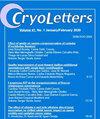Cryopreservation of zygotic embryos of Podophyllum hexandrum Royle, an endangered medicinal plant, by vitrification and v cryo-plate techniques.
IF 0.9
4区 生物学
Q3 BIOLOGY
引用次数: 0
Abstract
BACKGROUND Podophyllum hexandrum is a highly endangered valuable medicinal plant of the Himalayas belonging to family Berberidaceae. This plant needs conservation efforts due to the over-exploitation and unscrupulous harvesting from the wild because of its ever-increasing demand. OBJECTIVE To establish a long-term cryopreservation method for Podophyllum hexandrum using two techniques: Vitrification and V Cryo-plate. MATERIALS AND METHODS Zygotic embryos were cryopreserved using vitrification and V cryo-plate by optimization of parameters including preculture time, loading time and PVS2 dehydration time. Recovery of zygotic embryos was performed on different regrowth media for plantlet formation. RESULTS With V cryo-plate, 90% regrowth was obtained as compared to 73.3% with vitrification. V Cryo-plate conditions were pre-culture of zygotic embryos in 0.3 M sucrose for 4 days, treatment in loading solution with 0.8 M sucrose for 20 min, dehydration in PVS2 for 50 min, LN exposure, unloading in 1.2 M sucrose for 20 min and transfer of zygotic embryos to regrowth medium for recovery. During recovery, the maximum number of shoots (4.2) and highest shoot length (5.1 cm) were observed on regrowth medium with 1.5 mg per liter BAP and 0.1 mg per liter IAA (R7). CONCLUSION Zygotic embryos of Podophyllum hexandrum were cryopreserved with 90% regrowth using a V cryoplate technique and plantlets were produced directly after cryopreservation. Doi: 10.54680/fr23410110712.玻璃化和冷冻板技术对濒危药用植物六脚木合子胚胎的低温保存。
背景木足(podophyllum hexandrum)是喜马拉雅地区小檗科高度濒危的珍贵药用植物。由于需求的不断增长,这种植物需要保护,因为过度开发和肆无忌惮地从野外采伐。目的采用玻璃化和V型冷冻板两种技术,建立木犀草的长期冷冻保存方法。材料与方法通过优化预培养时间、加载时间和PVS2脱水时间,采用玻璃化冷冻法和V型冷冻板对受精卵进行冷冻保存。在不同的再生培养基上进行了合子胚胎的再生,以形成植株。结果冷冻板的再生率为90%,玻璃化板的再生率为73.3%。V冷冻板条件为:将受精卵在0.3 M蔗糖中预培养4 d,在0.8 M蔗糖的上样液中处理20 min,在PVS2中脱水50 min, LN暴露,在1.2 M蔗糖中卸载20 min,然后将受精卵转移到再生培养基中恢复。在BAP浓度为1.5 mg / l、IAA浓度为0.1 mg / l (R7)的再生培养基上,再生芽数最多(4.2),芽长最多(5.1 cm)。结论采用V型冷冻板技术冷冻保存六脚木合子胚胎,再生率达90%,冷冻后可直接获得植株。Doi: 10.54680 / fr23410110712。
本文章由计算机程序翻译,如有差异,请以英文原文为准。
求助全文
约1分钟内获得全文
求助全文
来源期刊

Cryo letters
生物-生理学
CiteScore
1.80
自引率
10.00%
发文量
50
审稿时长
1 months
期刊介绍:
A bimonthly international journal for low temperature sciences, including cryobiology, cryopreservation or vitrification of cells and tissues, chemical and physical aspects of freezing and drying, and studies involving ecology of cold environments, and cold adaptation
The journal publishes original research reports, authoritative reviews, technical developments and commissioned book reviews of studies of the effects produced by low temperatures on a wide variety of scientific and technical processes, or those involving low temperature techniques in the investigation of physical, chemical, biological and ecological problems.
 求助内容:
求助内容: 应助结果提醒方式:
应助结果提醒方式:


